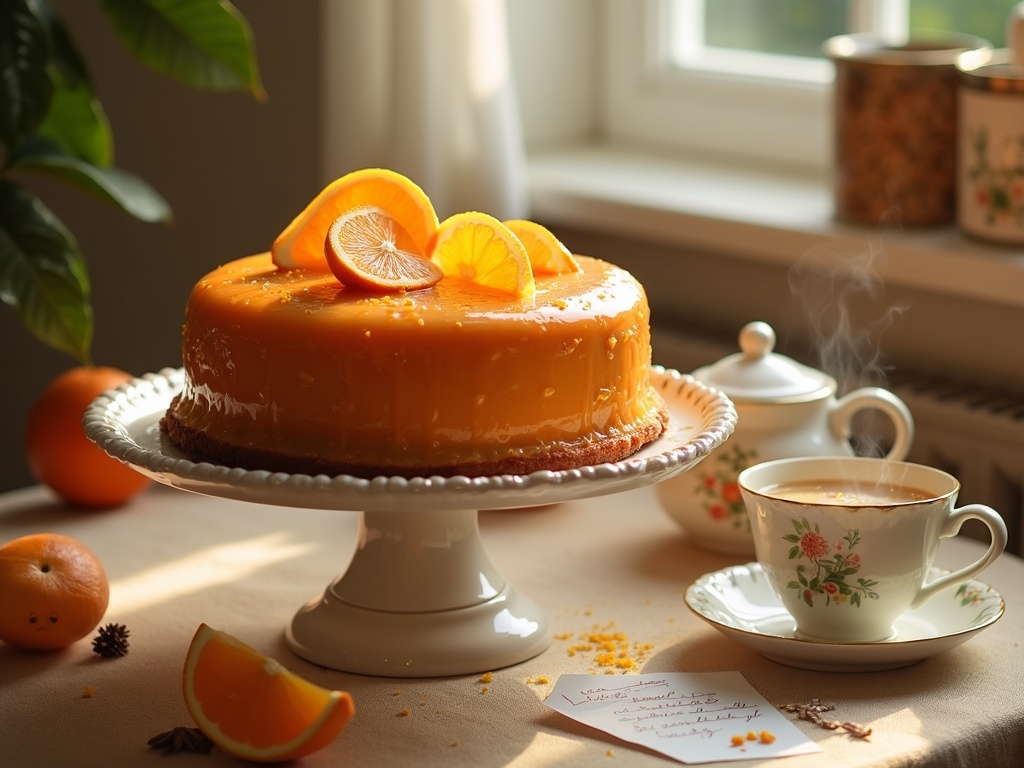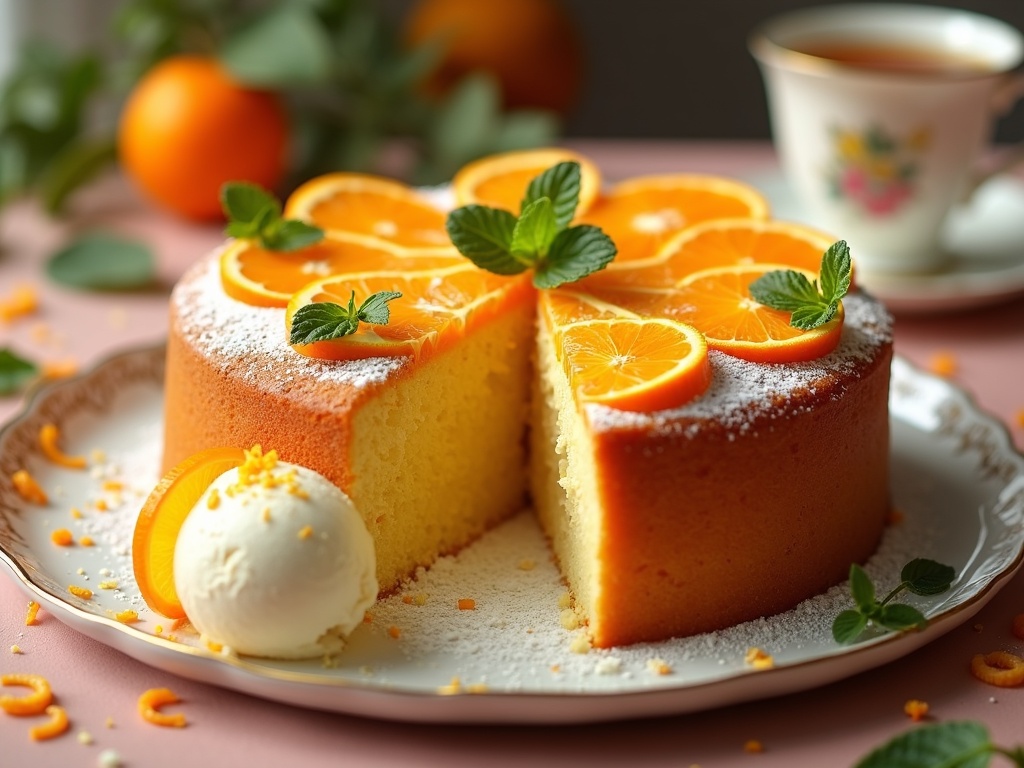This orange cake recipe combines fresh orange juice and zest to create a vibrant, authentic citrus flavor that makes it a standout dessert for any occasion. The cake strikes a perfect balance of moisture and texture through precise ingredient measurements and correct baking methods, delivering a dessert that’s both refreshingly tangy and comfortingly sweet.
Find In This Article
Key Takeaways
- Use fresh orange juice and zest from two large oranges to achieve an authentic citrus flavor rather than artificial alternatives.
- The recipe requires 1.5 cups of sugar and 2 cups of all-purpose flour, creating the ideal moisture level and structure.
- Bake at exactly 350°F (175°C) for 25-35 minutes, checking doneness with a toothpick test.
- The cake can be topped with classic buttercream, cream cheese frosting, or a simple orange glaze for different flavor profiles.
- Fresh garnishes like orange slices and mint leaves elevate the presentation, making it suitable for both casual gatherings and special occasions.
What Makes This Orange Cake Special
This orange cake has become my go-to dessert for both special occasions and casual get-togethers. The secret lies in using fresh ingredients that maximize the citrus flavor profile while maintaining a perfect texture balance.
Authentic Citrus Flavor and Perfect Texture
The vibrant taste comes from using fresh orange juice and zest from two large oranges rather than artificial flavorings. This approach creates a genuine citrus experience that processed alternatives simply can’t match. I’ve found that extracting both the juice and zest captures the complete essence of the fruit – the zest contains aromatic oils that give the cake its distinctive fragrance, while the juice contributes moisture and tanginess.
The cake achieves its ideal moisture level through a careful balance of 1.5 cups of sugar and fresh ingredients. Unlike some cakes that can be either too dry or overly soggy, this recipe hits the sweet spot of moistness that allows the orange flavor to shine without compromising the cake’s structure. The sugar doesn’t just add sweetness – it interacts with the citrus acids to create a balanced flavor profile that isn’t overpowering.
This recipe has earned its reputation through generations of bakers who appreciate its reliability and crowd-pleasing results. I’ve served this at birthday celebrations, holiday gatherings, and casual coffee dates, always receiving compliments on its refreshing flavor. The versatility makes it particularly special – it can be dressed up with a frosting for special vegan celebrations or enjoyed plain with afternoon tea.
For those who appreciate baking traditions, this cake carries the same comforting appeal as a classic madeira cake recipe but with a bright citrus twist. If you’re concerned about dietary restrictions, you’ll be pleased to know this recipe can be adapted into an eggless version without sacrificing its signature taste.
The orange cake fits perfectly into various serving contexts:
- Family gatherings where a nostalgic, homemade dessert creates warmth and connection
- Afternoon tea settings where its bright flavor complements both hot and cold beverages
- Gift-giving occasions when packaged in a decorative container with a handwritten note
- Brunch menus where its citrus notes balance savory dishes
For those who enjoy fruit-based baked goods, this orange cake shares similar qualities with a good banana loaf – it’s reliable, comforting, and makes excellent use of fresh fruit. The recipe also pairs wonderfully with other fruity desserts when creating a dessert spread for larger gatherings.
What truly sets this orange cake apart is how it balances simplicity with distinctive flavor. Unlike more complex plum cake recipes that might require special techniques, this orange cake remains accessible to bakers of all skill levels while delivering results that taste anything but basic.

Essential Ingredients and Equipment You’ll Need
Creating the perfect orange cake starts with gathering quality ingredients and the right equipment. I’ve baked this cake countless times and found that fresh ingredients make all the difference in bringing out that vibrant citrus flavor.
Key Ingredients
The foundation of any great orange cake begins with simple but important components. You’ll need 2 cups of all-purpose flour which provides the structure for your cake. Combine this with 1.5 cups of granulated sugar to achieve the perfect level of sweetness that complements the citrus notes without overpowering them.
Eggs are crucial for binding and adding richness – this recipe calls for 4 large eggs at room temperature for best results. The star ingredients that give this cake its distinctive flavor are 1 cup of freshly squeezed orange juice and zest from 2 large oranges. I always recommend using fresh oranges rather than bottled juice as the flavor is much more pronounced and natural.
Don’t forget the leavening agents! You’ll need:
- 2 teaspoons of baking powder
- 1/2 teaspoon of salt to balance the sweetness
- 1/2 cup of vegetable oil for moisture
- 1 teaspoon of vanilla extract to enhance the orange flavor
Fresh orange juice adds incredible moisture to your vegan orange cake alternative if you’re looking to make this recipe egg-free. The zest contains essential oils that provide that intense orange flavor that makes this cake special.
Equipment You’ll Need
For the equipment side, you don’t need anything fancy, but a few key items will make the process smoother. A stand mixer or hand mixer will help you achieve the perfect cake batter consistency, though you can mix by hand if needed. A 9-inch cake pan is ideal for this recipe, but you can also use a bundt pan for a more decorative presentation.
Other helpful equipment includes measuring cups and spoons for accuracy, a microplane or fine grater for zesting the oranges, and a citrus juicer to extract the maximum juice from your oranges. A toothpick or cake tester will help you determine when your cake is perfectly baked.
If you’re looking to try variations on this recipe, consider checking out other citrus-based cakes like a classic Madeira cake which has a similar dense, moist texture but with a different flavor profile.
For those with dietary restrictions, this recipe can be adapted to create an eggless orange cake by substituting the eggs with yogurt or applesauce. The orange juice already adds significant moisture, making this cake recipe particularly forgiving for such modifications.
I find that preparing all ingredients before starting makes the baking process much smoother. Measure everything out, juice and zest your oranges, and bring refrigerated items to room temperature. This preparation step often makes the difference between a good cake and a great one.
When selecting oranges, look for fruits that feel heavy for their size and have bright, fragrant peels – these will provide the best flavor. Naval oranges work wonderfully for this recipe, but blood oranges can create an interesting flavor and color variation if you’re feeling adventurous.

How to Make Your Orange Cake Perfect
Perfecting an orange cake requires careful attention to timing and technique. I’ve found that following specific steps ensures your cake turns out moist, flavorful, and utterly delicious every time.
Preparation and Mixing Techniques
Preheating your oven to exactly 350°F (175°C) is crucial. This specific temperature creates the perfect environment for the cake to rise evenly without drying out the edges. While the oven heats up, I separate my ingredients into two bowls – dry ingredients in one and wet in another. This separation prevents the flour from clumping when it meets liquid ingredients.
For the dry mix, I sift the flour, baking powder, and salt together to remove any lumps. The sifting also incorporates air into the mixture, contributing to a lighter texture in the finished vegan orange cake alternative.
The most critical step comes when mixing the eggs and sugar. I whisk them together until the mixture becomes pale and fluffy – this usually takes about 3-4 minutes with an electric mixer. This process, called creaming, creates tiny air bubbles that expand during baking, giving your cake its soft, tender crumb.
Baking Time and Doneness Tests
The baking time of 25-35 minutes can vary based on your oven’s peculiarities. I start checking my orange dessert cake at the 25-minute mark by inserting a toothpick into the center. If it comes out clean or with just a few crumbs, the cake is ready. If wet batter clings to the toothpick, I continue baking and check again every 3-5 minutes.
Key timing points to remember:
- 25 minutes – first doneness check
- 30 minutes – ideal baking time for most ovens
- 35 minutes – maximum baking time (watch carefully to prevent over-baking)
The cake should spring back lightly when touched in the center, and you’ll notice the edges starting to pull away from the sides of the pan. These visual cues, combined with the toothpick test, will help you achieve the perfect eggless orange cake option if you’re adapting the recipe.
Remember that carryover cooking continues even after you’ve removed the cake from the oven, so it’s better to slightly underbake than overbake your orange cake for the most moist and flavorful results.
Dress It Up With These Frosting Options
The right frosting can transform a simple orange cake into a showstopping dessert. I’ve found that pairing the bright citrus flavor with complementary frostings creates a perfect balance that enhances the cake without overpowering it.
Classic Buttercream
Nothing beats a classic buttercream for versatility and rich flavor. To make this tried-and-true option:
- 3 cups powdered sugar
- 1 cup butter (at room temperature)
- 1-2 tablespoons orange zest for extra flavor
- 1-2 tablespoons orange juice for consistency
Beat the butter until fluffy, then gradually add the powdered sugar. Mix in the orange zest and juice until you reach your desired consistency. This frosting pairs beautifully with classic Madeira cake recipes and works perfectly with orange cake too.
For smooth results, I always let my cake cool completely before frosting. Using an offset spatula helps achieve those professional-looking swirls and even coverage.
Cream Cheese Frosting & Simple Glaze
For a tangy alternative that cuts through the sweetness, cream cheese frosting works wonders:
- 8 oz cream cheese (room temperature)
- 1/2 cup butter (room temperature)
- 4 cups powdered sugar
- 1 teaspoon vanilla extract
- 1 tablespoon orange zest
Beat the cream cheese and butter together until smooth, then gradually add the powdered sugar and other ingredients. This creates a luxurious topping that complements the vegan cake variations and traditional recipes equally well.
If you prefer a lighter finish, a simple orange glaze delivers bright flavor without the heaviness:
- 2 cups powdered sugar
- 3-4 tablespoons fresh orange juice
- 1 teaspoon orange zest
Mix until smooth and pour over your cooled cake. This glaze sets with a beautiful sheen and is perfect for eggless cake recipes or when you want the orange flavor to take center stage.
For professional-looking results, I chill my cake before applying the final coat of frosting. This creates a “crumb coat” that seals in any loose crumbs. Another tip: dip your spatula in hot water and wipe dry between strokes for that perfectly smooth finish that will make your homemade desserts look bakery-worthy.

Serving Ideas and Presentation Tips
Presentation makes all the difference when serving an orange cake. I’ve found that a few simple touches can transform this dessert from merely delicious to absolutely spectacular. The vibrant color and refreshing citrus flavor of orange cake offer countless opportunities for creative serving ideas.
Garnishing for Visual Impact
Garnishing your orange cake elevates its appearance instantly. Fresh orange slices arranged in a circular pattern on top create a stunning visual effect that hints at the flavor inside. I like to add a few mint leaves for color contrast—the bright green against the orange creates an appealing combination that looks professional with minimal effort.
Here are some garnishing options to consider:
- Thin orange slices, slightly overlapped around the cake’s perimeter
- Candied orange peel scattered across the top
- A light dusting of powdered sugar over a paper stencil for an elegant pattern
- Fresh mint leaves placed strategically for pops of green
- Edible flowers for special occasions
Perfect Pairings and Serving Suggestions
The perfect orange cake deserves the perfect accompaniment. A scoop of vanilla ice cream alongside a warm slice creates a delightful temperature contrast and complements the citrus flavor beautifully. For a more sophisticated approach, I recommend serving with a dollop of lightly whipped cream infused with a hint of orange zest.
When serving, cut the cake into 10-12 even slices for the most appealing presentation. I find using a sharp knife dipped in hot water between cuts gives the cleanest edges. Serve the cake at room temperature to fully appreciate its flavor profile, though in summer months, a slightly chilled cake can be refreshing.
For storage, keep your orange cake in an airtight container at room temperature for up to three days. If you need to store it longer, refrigeration works well for up to a week—just bring slices back to room temperature before serving. The cake pairs wonderfully with various dessert options for a complete spread, or alongside a hot cup of Earl Grey tea for an afternoon treat.
For a vegan-friendly alternative, serve with dairy-free ice cream or coconut whipped cream—the tropical notes actually enhance the citrus flavor profile beautifully.

Know Your Slice
Understanding the nutritional profile of my orange cake helps me make informed choices about portion sizes and fit it into a balanced diet. Each slice of this cake (based on cutting the cake into 10 equal portions) contains approximately 350 calories. The caloric content primarily comes from 18g of fat and 45g of carbohydrates, with a modest 4g of protein per slice.
Smart Portion Control
I’ve found that being mindful about serving sizes doesn’t mean I can’t enjoy this delicious treat. Here are some practical approaches to portion control that don’t sacrifice satisfaction:
- Use a cake marker or guide to ensure uniform slices when serving
- Serve on smaller dessert plates rather than dinner plates to create the illusion of a larger portion
- Pair a half-slice with fresh fruit for a lighter dessert option
- Cut individual slices and freeze them separately to avoid the temptation of seconds
- Consider making mini orange cakes using a muffin tin for built-in portion control
When I’m feeling extra health-conscious, I sometimes swap traditional frosting for a light vegan glaze option that reduces the overall calorie count. For special occasions when I want something similar but different, I might prepare a fruit-based cake that offers comparable flavor satisfaction.
The good news is that this orange cake recipe contains real orange zest and juice, which provides natural flavor and some nutritional benefits. For those looking to adjust the recipe for dietary needs, exploring eggless alternatives can maintain the cake’s structure while accommodating restrictions.
I’ve noticed that serving this cake with a small side of fresh orange segments or berries not only enhances the presentation but also adds nutritional value to the dessert experience. This simple addition makes the portion feel more substantial while adding vitamins and fiber to offset the indulgence.
Remember that enjoying desserts like this orange cake can absolutely be part of a balanced approach to eating—the key is awareness and moderation rather than complete restriction.
Sources:
Delicious Magazine, Ultimate Orange Cake Recipe
Joy of Cooking, Baking Basics
U.S. Department of Agriculture, Food Data Central

